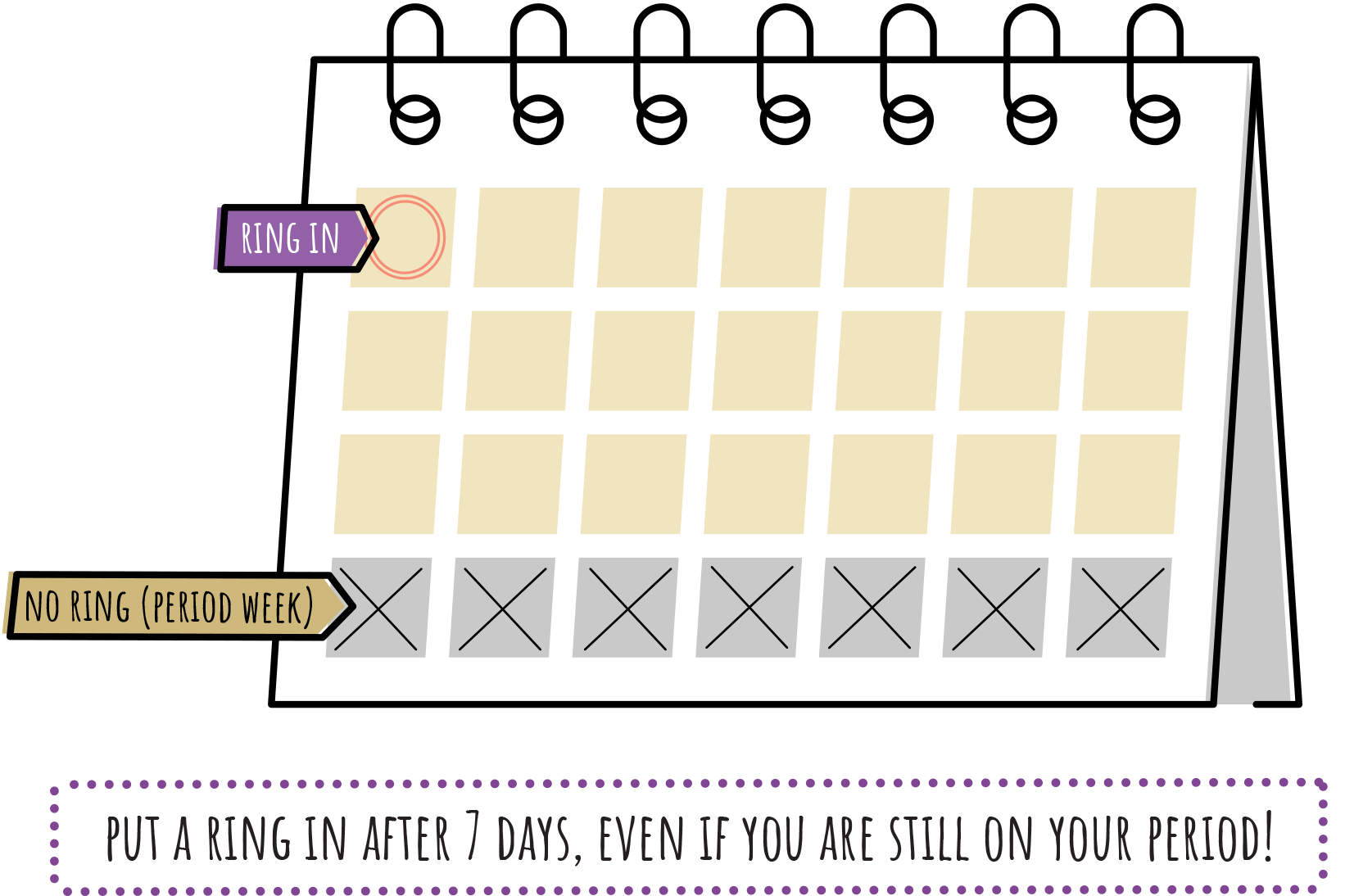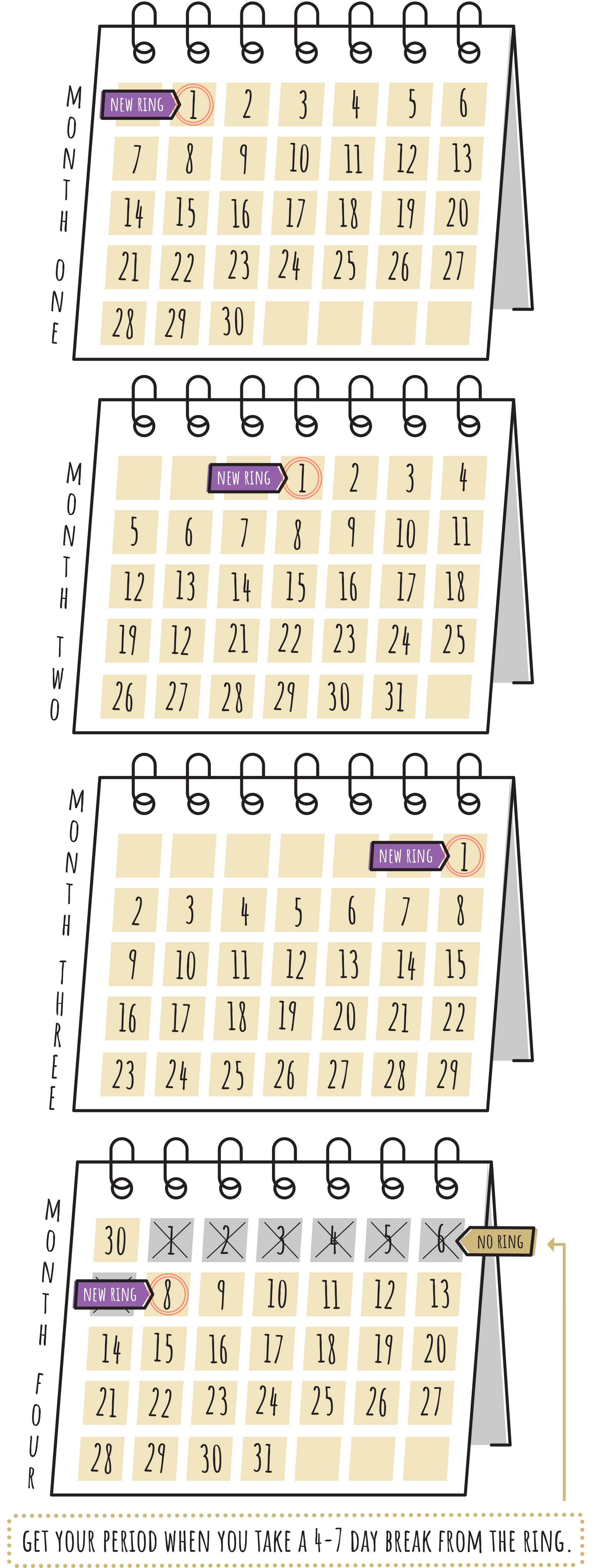The Ring
The Ring: Quick Facts

- The ring is placed into the vagina and releases medication into the blood stream.
- For many people, the ring is easier to use than taking a pill every day.
- The ring is a treatment for problem periods. It can help with heavy, irregular, or painful bleeding. It can also help with other period concerns.
- The medication in the ring keeps the lining of the uterus thin and blocks ovulation. It also helps to prevent acne.
- The ring is a safe medication for most people to use.
- There are 2 different rings available: a monthly ring (EluRyng/NuvaRing®) and one that has medication for an entire year (Annovera®).
Learn More
How do I get started on the ring?
Start your ring today or as soon as you get it from the pharmacy. Make a note in your calendar so you know what day and date the ring is started.
How do I put in the ring?
1) Remove the ring from its package.
2) Find a comfortable position such as squatting, laying down, or with 1 leg up on the side of the toilet.
3) Use your thumb and index finger to squeeze the ring into an oval shape.
4) Push the ring into the vagina. Once it’s inside, push the ring up as high as you can. If it feels uncomfortable, it needs to be pushed up higher. There is no correct position for the ring once it is completely inside the vagina. You will not be able to feel it once it’s there.
How do I remove the ring?
When it is time to remove the ring, put your index finger into the vagina and hook the ring with your finger. Pull down on the ring and slide it out. If you are using the monthly ring, wrap it up in tissue and put in the trash. If you are using Annovera®, wash it with mild soap and water, pat dry, and store in its case until time to reinsert.
When you remove the ring depends on what your plan is for having periods: 1) each month, 2) every 3 months, or 3) only when needed because of breakthrough bleeding.
What if I am having a hard time putting in or taking out the ring?
If you are having problems inserting the monthly ring, it can be helpful to slide the ring inside an empty tampon applicator. The applicator can then be put inside the vagina, and the ring pushed out the top, higher into the vagina.
1) Start with a super-sized tampon that has a curved plastic applicator; remove the cotton tampon and the plunger.
2) Fold the ring and slide it into the applicator from the bottom.
3) Slide the applicator (with the ring inside) into the vagina.
4) Use your finger or the plunger to push the ring outside the top of the applicator and into the vagina.
Please call or MyChart message our clinic if you are having any problems using the ring and we can talk about them.
How can I use the ring to have a period each month?
If you want to have a period every month, leave the ring in for 3 weeks (= 21 days), and then remove for one week. You will have your period this week.
Insert a new ring, or re-insert Annovera®, after 7 days. It is OK to put in the ring even if you are still on your period. It is safe to use tampons at the same time as the ring when needed.
How can I use the ring to have a period every 3 months (extended dosing)?
If you want to have a period every 3 months (this is called “extended dosing”)...
For the monthly ring:
Insert the ring and note this date of the month. Insert a new ring on this same date of the next month. Alternatively, you can insert a new ring every 4 weeks.
Leave the ring out for 4-7 days. You will have a period during this time. It is OK to insert a new ring if you are still on your period. It is safe to use a tampon at the same time when needed.
To do extended dosing with Annovera®:
Insert the ring and note this date of the month. Remove the ring 3 months later, on the same date. Wash with mild soap and water, pat dry, and store in its case while not using it.
Leave the ring out for 4-7 days. You will have a period during this time. It is OK to reinsert Annovera® if you are still on your period. It is safe to use a tampon at the same time when needed.
How can I use the ring to not have a period (continuous dosing)?
Only when needed, if you want to have no scheduled periods (continuous dosing)...
For the monthly ring:
Insert the ring and note the date of the month. Insert a new ring on the same date of the next month. Alternatively, you can insert a new ring every 4 weeks.
For Annovera®:
Insert the ring and note the date. Plan to remove the ring and wash with mild soap and water every 3 months and then immediately re-insert the ring.
If you have bleeding with the ring in place remove the ring for 4-7 days and start over.
What if the ring falls out or comes out?
The ring is not likely to fall out. If it does come out, wash it with mild soap and water, then place it back inside the vagina.
Do not leave it out for more than 2 hours unless you are planning on taking a 4 to 7 day break from using it.
What are the possible side effects from the ring?
Most users of the ring have no side effects.
Some people will notice a change in their vaginal discharge.
For the first week, a few people will have mild stomach upset, mild headache, or breast tenderness. Let our clinic know if these are issues for you, or they continue longer than 2 weeks.
The ring is not thought to cause weight gain or depression. Talk to your provider if you have these concerns before or while you are using the ring.
The ring is a safe medication to use, but there is a very tiny increased risk of blood clots (called a venous thrombosis, VTE, or a deep venous thrombosis, DVT.) There is a small risk of having a blood clot even when not using estrogen-containing medication. People with additional risk factors for blood clots should avoid the use of the combined pill, patch, and ring, and instead use progestin-only treatments to help with periods or for contraception.
What if I forget to change the ring?
The monthly ring has 5-weeks of medication inside. If it has been 5 weeks or less since you have placed the ring, remove the ring and do a 7-day break if you want to have monthly periods, or replace with a new ring if using in an extended or continuous way.
Annovera® has 1 year of medication inside. If you are late to remove the ring, continue to use as planned from that time on.
Call or Mychart our clinic if your situation is different or you have other questions.
How should I store the ring when not in use?
For unopened rings or a ring that is not in use, do not leave anywhere that reaches extreme temperatures. This means hotter than 80 degrees or below freezing. (Your car glove box is NOT a good place to keep the ring!)
The monthly ring can be stored for 3 months in a place that does not reach over 80 degrees. You can store rings in the refrigerator if you would like, but this is not required.
Annovera® can be stored in its case when not in use. Don’t let it be exposed to extreme temperatures. Note that the Annovera® ring may become slightly darker in color over time. This is to be expected and not a cause for concern.
How can I get refills of the ring?
For the monthly ring, most insurance companies will provide 3 rings at a time, and you may be able to get a year-supply if requested.
For Annovera®, this ring contains medication for 1-year. Call the pharmacy for a refill one month before you get to your 1-year anniversary.
If you have health insurance, your ring should not have any cost or co-pay.
If you are having any problems getting or using the ring, call or MyChart message our office and we will help.
What to know when using the ring as birth control?
It takes 7 days for the ring to be an effective method of birth control.
There is no reason to remove the ring to have sex. Your partner is not likely to feel it, and if they do, it is soft and will not be bothersome.
If you do remove the ring for any reason, make sure it is replaced within 1-2 hours.
Avoid using oil-based lubricants or vaginal anti-yeast creams as they may change the way the medication in the ring is released.
The ring does not prevent STI’s. Use condoms and get tested at least each year.








